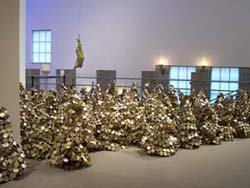
Peak Project
1999
Tin and copper wire
Collection of the artist
As Anatsui explains, his new series of work was inspired by "huge piles of detritus from consumption," such as the mountains of milk tins and bottle tops that have been growing throughout West Africa due to limited recycling technology. "A lot of things which are made in Europe and America and are sent over arrive in certain kinds of packaging, for example, fresh milk comes in tins. We have our own milk too, of course, but in addition there are huge imports of milk from outside, which is accessed by way of tins." This work examines consumption and the various physical landmarks that trash generates in different parts of the world.
When asked specifically about his use of milk tins in Peak Project, Anatsui remarked, "The format that I find very effective with them is piling them into heaps--or peaks, since the commonest brand is Peak Milk! They mutate effectively because we don't tie them too tightly, there is always the freedom for each piece to adjust itself. So as you lift and place them down they keep adjusting until a form firms up."
|
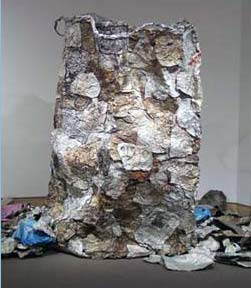
Wastepaper Bag
2003
Aluminum plates and copper wire
Collection of the artist
In working with aluminum, Anatsui intends to "subvert the stereotype of metal as a stiff, rigid medium and rather reveal it as a soft, pliable, almost sensuous material capable of attaining immense dimensions and being adapted to specific spaces." Yet the forms he creates are layered with meanings that reach beyond the physical characteristics of the materials he chooses. In this eight-foot-tall sculpture of an oversized wastepaper bag Anatsui makes a blatant statement about the rising problem of waste transformation in nations with limited recycling capabilities. More subtly, however, this piece also comments upon the all-too-often disposable nature of human life. Made from discarded printing plates used for newspaper obituary pages, these images and announcements of the dead remind us of the continuous scourge of disease, crime and persecution in a nation struggling with the long-term effects of post-colonialism, underdevelopment and political corruption.
|
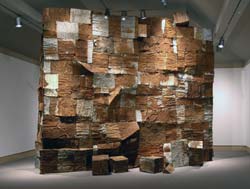
Crumbling Wall
2000
Steel sheets
Collection of Audrey and David Mirvish, Toronto, Canada
Anatsui typically uses readily available local resources as materials for his sculptures. In this work, he transforms old graters--once used to prepare gari, a West African staple made from cassava flour--into an architectural form of densely perforated sheets of rusted metal. The wall is in effect an homage to gari, which is often consumed as the main meal in the form of dough or a thin porridge. The production of gari is long and tedious, and the manual grater is usually only a piece of galvanized sheet metal, or even a piece of flattened can or tin, punched with three-millimeter nails that leave a raised, jagged flange on the underside. The cassava pieces are rubbed vigorously against the flange with strong downward movements. This hand grating, the most painful operation in the making of gari, figuratively represents the resilience of African traditions and peoples in the face of change. Crumbling Wall--a "monumental dirge" according to Nigerian art historian and critic Sylvester Ogbechie--can also be seen as a metaphor for the destruction and corruption evident in modern African politics and the decay of the once-beautiful structures that decorated Africa's cultural landscape.
|
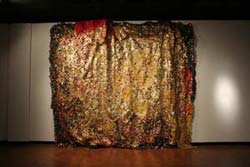
Skin of Earth
2006
Aluminum and copper wire
Ilene and Stanley Gold Collection, Los Angeles
In Nigeria, local distilleries produce dozens of brands of spirits in bottles of various sizes that are recycled after use. The distilleries recycle each other's bottles interchangeably but discard the old aluminum tops, seals and labels in the process, which Anatsui then transforms into works of art that reflect the social "lives" and meanings of the original objects from which the cloth is made. The artist explains that these works "become loaded--'charged' is maybe the right word--with a lot of meaning, and talking about all the various states that they've gone through or the various uses that they've been put to--this is all written upon them."
|
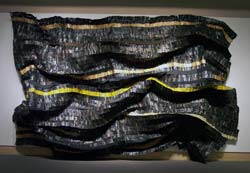
Adinkra Sasa
2003
Aluminum and copper wire, fabric
Collection of the artist
As the title implies, this metal cloth makes reference to adinkra, the dyed cloth with stamped designs made by the Akan peoples of Ghana. When used for mourning, adinkra cloths are typically dyed dark brown, brick red or black. The designs stamped on them with a bark and iron slag mixture impart a highly valued, glossy surface. Many of the adinkra stamp designs are named for proverbs or aspects of nature and thus layered with additional meanings. The Ewe term sasa may be defined as "patchwork," and the artist has chosen it to lament the balkanization or carving up of Africa by European colonial powers.
|
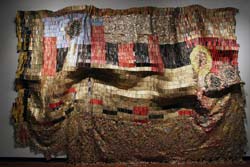
Many Moons
2007
Aluminum and copper wire
Miriam Wosk Collection, Los Angeles
This work was first shown in 2007 for the presentation of Gawu at the Fowler Museum at UCLA and was created immediately prior to the exhibition opening. In a sense, however, all of the sculptures included in this exhibition are "new." The artist actively participates in installing his works, draping clothlike pieces and arranging component parts, so that each time they are shown they acquire a unique aspect. Just as Anatsui's art deals with imparting new meaning to and transforming detritus, his artworks themselves are continuously evolving and undergoing transformation. According to the artist, the title of this work refers to time and the tradition in West Africa of marking the identity of a village by the day of its weekly market.
|
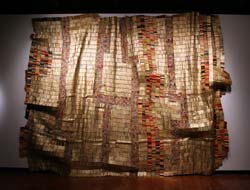
Versatility
2006
Aluminum and copper wire
Fowler Museum at UCLA, museum purchase, X2007.7.1
As Anatsui notes, his metal cloths "encapsulate the essence of the alcoholic drinks which were brought to Africa by Europeans as trade items at the time of the earliest contact between the two peoples." To create these cloths, Anatsui uses labels from local Nigerian brands of whiskey, rum, vodka, brandy and other potent libations with names such as Chairman, Dark Sailor, King Solomon, Makossa, 007, Top Squad and Ecomog (named after the multilateral, though largely Nigerian, armed force established in 1990 to intervene in the Liberian civil war). A motif that appears in both adinkra and kente cloths is visible in the patterning of this work and is referenced in its title, Versatility, which according to the artist, suggests the notion of adaptability and the twists and turns of human existence.
Kente is a strip-woven cloth that is made by the Asante peoples of Ghana and the Ewe peoples of Ghana and Togo. It is a festive dress for special occasions--traditionally worn by men as a kind of toga and by women as an upper and lower wrapper. Adinkra is a system of graphic symbols that appear as two-dimensional designs on dyed and stamped textiles and as three-dimensional motifs ornamenting carved and cast objects, including jewelry. Dark-colored adinkra cloths are funerary attire, while those of brighter hues may be worn on other special occasions. Both kente and adinkra patterns communicate cultural and philosophical meanings, social codes of conduct, religious beliefs, political thought and aesthetic principles. On a global level, kente cloth has become an overriding symbol for African-ness.
Looking back at his work over the course of his artistic career, Anatsui recalls that his father and his brothers wove the more muted kente of the Ewe peoples, and he speculates about the unconscious influence of family and cultural history upon him, "I have discovered only much later . . . that cloth has been a recurring theme or leitmotif, and it is featured in so many dimensions." This spectacular metallic "cloth," whose surface suggests a woven structure, is constructed from thousands of flattened and sewn strips of pliable aluminum that once wrapped the necks of discarded liquor bottles.
|
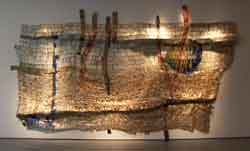
Blue Moon
2008
Aluminum and copper wire
Collection of the artist
|
|
|
 |
|
| |

